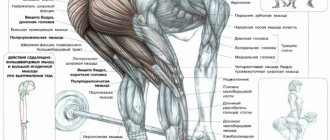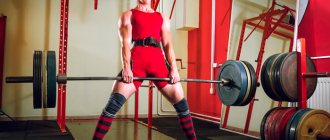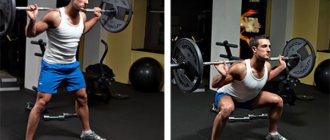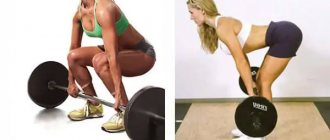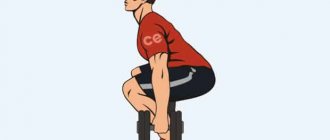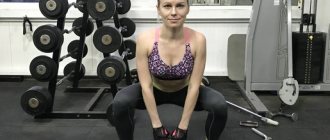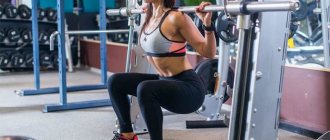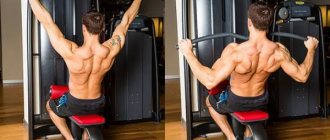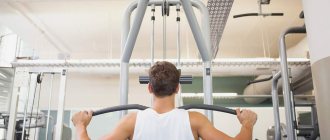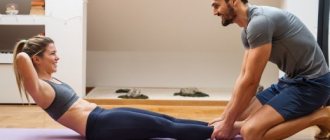Classic deadlifts are not for everyone. Firstly, this complex multi-joint exercise is not recommended for beginners, since the muscles are not yet ready for the traction technique, and secondly, physiologically the exercise causes pain, most often in the lumbar region, and the reason for this is not even diseases and injuries of the spine, but morphological features . And there is an alternative to such an exercise - this is its variation with dumbbells. Let's look at the benefits and disadvantages of the dumbbell deadlift, and whether it's worth replacing the barbell deadlift.
The benefits of dumbbell deadlifts
The classic version of the deadlift, as you know, is performed with a barbell, with the load being distributed to a greater extent on the back muscles, then on the quadriceps, and to a lesser extent on the buttocks and hamstrings. If for men this is most often a mandatory exercise, then for many girls it is not of particular significance or benefit.
It is the deadlift version with dumbbells that is more justified for the female body, since it does not overload the back and quadriceps, and to a greater extent develops the gluteal muscles and hamstrings.
In addition to aesthetic benefits, there are also anatomical ones. That is, for those who are contraindicated in deadlifting with a barbell due to the physiological characteristics of the body, pain and spinal injuries, the option with dumbbells will be more comfortable and safer.
Another morphological aspect is that not everyone is comfortable holding the barbell with an overhand grip, in which the hands are in a pronated position. When holding dumbbells, this moment is smoothed out, since the position of the shoulder joints can be controlled by holding the dumbbells with a parallel, neutral grip.
Sumo Deadlift: Theoretical Basics
As usual, you should start with a theoretical basis in order to better understand what exactly happens to the body during the exercise. As you can guess from the name, the sumo deadlift is used mainly by sumo athletes, for whom impressive mass is an important indicator. This type of deadlift is distinguished by the special position of the legs - they are widely spread to the sides, which helps to pump a larger percentage of the muscles during training (in particular, the muscles of the back and legs).
When performing a sumo deadlift, an athlete simultaneously performs 8 movements at once, affecting different muscle groups: straight-arm pulldowns, wrist curls, shrugs, abdominal crunches, back extensions, leg curls, leg presses and, finally, calf raises.
It is also worth paying special attention to the difficulty of performing a sumo deadlift. Research has shown that traditional squats and bench presses, so popular among athletes, cause preliminary stretching of the muscles, which then helps to return the apparatus to its original position. In the sumo deadlift, there is no such stretch - the lifting of the bar occurs solely due to the athlete’s willpower.
Since most athletes have never even heard of the sumo deadlift, it's worth considering the advantages and disadvantages of this exercise compared to the classic deadlift.
Disadvantages and contraindications for deadlifting with dumbbells
The only disadvantages of the exercise include the requirement for flexibility and elasticity of the muscles and ligaments of the back surface of the body. If there is insufficient flexibility, with tight and shortened muscles, when performing deadlifts with dumbbells, the hamstrings are subjected to strong tension, which can cause serious injuries. Therefore, inflexible and previously injured muscles and tendons should not be subjected to such stress.
Contraindications include spinal injuries, hernias, displacements, protrusions, pinched nerves, and back pain. As well as injuries and inflammation in the muscles and ligaments of the back of the body.
Features of the technique
Beginners are wondering what muscles work when deadlifting? This technique involves lifting a sports equipment using the strength of the following muscles:
- gluteal;
- housings;
- upper spinal region;
- back of the legs.
At first glance it seems that this is a simple task, but in reality there are many nuances to its implementation.
Benefits of the training
Deadlift brings the following benefits:
- forms a powerful physique;
- strengthens the abdominal muscle area;
- develops strength;
- helps burn fat;
- improves posture and physical fitness;
- one of the safest exercises.
The degree of influence of the exercise on different muscle groups
What does a deadlift do? The work is distributed as follows:
· the main load falls on the latissimus dorsi muscles and spinal extensors. The training actively includes the femoral biceps, quadriceps and gluteal area;
· additional load is distributed between the hands, forearm and trapezius muscles;
· the abs, calf segment and inner thighs are also involved.
Execution technique
Before performing a deadlift, the muscles need to be warmed up. Next take the following steps:
- stand straight, spread your lower limbs to hip width, turn your feet to the sides;
- the bar lies on the floor, its rod goes in the middle of the foot, being as close to the leg as possible;
- the wrists are set narrowly on the bar and touch the kneecaps;
- lowers himself in a downward motion so that his knees are inside his hands;
- straighten the joints of the upper limbs and fix the elbows;
- What muscles does the deadlift engage in the process of straightening the back? These are the abs, the femoral posterior segment and the muscular part of the body;
- Before starting the exercise, you should make sure that the starting position is correct. It is recommended to check the position of the feet and the proximity of sports equipment to the legs. When squatting, it is not advisable to go very low and not protrude your knee joints beyond the level of your toes;
- the shoulders protrude slightly beyond the border of the bar, and the gaze is directed in front of oneself and slightly down;
- Without moving your body weight onto your toes or swaying, stick your sternum forward and then rise up, holding the steel rod close to your feet;
- the method of lowering the sports equipment in the deadlift involves first tilting the hips back;
- lower the projectile to the knees, then slowly bend the knee joints;
- When moving down, the spinal region is in a neutral position; there is no need to bend it down or up.
What muscles are used when deadlifting? Trainers claim that when performing it, about 70% of the muscles of the entire body are involved in the work.
What muscles work
- Large gluteal muscles.
- Spinal erector muscle.
- Semitendinosus muscle.
- Biceps femoris muscle.
- Semimembranosus muscle.
- Abdominal muscles - perform a stabilizing function.
Common mistakes
The most common shortcomings are as follows:
- straightened legs. This is where overload on the joints occurs;
- if the spine is not in a strictly vertical position, there is a risk of overstraining the stabilizing muscles and displacement of the vertebrae;
- when the spinal column rounds, pinched nerves and back damage can occur;
- Transformation of a deadlift into a full squat. The first technique involves a half squat;
- projectile rotation. It is not recommended to lift weights on bent upper limbs, this leads to rupture of the biceps;
- when grabbed, the body leans back. In this position, the knees also bend, which is against the rules. An unnatural slope of the lower back sometimes provokes the development of serious diseases. For example, intervertebral hernia;
- use of high-soled shoes. Trainers advise doing this exercise in socks or special flat shoes. It is easier to prevent stress and maintain balance in them.
Technique for performing deadlifts with dumbbells
First of all, let's look at performing deadlifts with stronger knee flexion, which emphasizes the load on the gluteal muscles:
- Take dumbbells in your hands and place the weight on the sides of your hips. Throughout the exercise, the arms always remain straight.
- Place your feet hip-width apart, parallel to each other.
- Bend your knees as if you were squatting and move your pelvis back, while leaning your torso forward as if you were trying to lie on your thighs. Your back should be as straight as possible; under no circumstances should you round your spine.
- As you inhale, lower yourself to the lowest point, but do not lower the dumbbells to the floor, your pelvis should not fall too low, and your knees should not be sharp. Keep your hands in a neutral position along your shins.
- As you exhale, straighten your torso using your gluteal muscles, pushing off with your heels.
Option with emphasis on hamstrings
The second embodiment can be classified as a variation of the Romanian deadlift, in which the knees bend to a lesser extent, which significantly increases the load on the biceps femoris muscles. In this case, the predominant movement is a downward bend, with a slight bend of the knees. When tilting the torso, we move the pelvis back, and the center of gravity shifts to the heels. The spine remains as straight as possible, and the slope reaches parallel with the floor. We lower the dumbbells down with a neutral grip along the shin, without touching the floor.
Equipment in video format
Execution technique
Without the correct technique, there is little use; on the contrary, it can lead to negative phenomena such as injury, despite the use of light weights.
Deadlift
Starting any basic exercise without a thorough warm-up on “cold” muscles is not only impractical, but also dangerous, as it is fraught with injury.
Deadlifts or straight-legged rows with dumbbells also involve warming up, since they are no exception to the generally accepted rules.
Particular attention should be paid to stretching the lower back. Performance:
- The starting position is the legs are slightly narrower than the athlete’s own shoulders, while looking in front of you without lowering your head.
- The legs at the knees are straightened and slightly relaxed, and their fixation will be ensured by the strength of the muscles, not the knee joint.
- The lower back is curved in such a way that the pelvic part moves (minimally) back.
- The shoulder blades are in a position characteristic of correct posture.
- The athlete’s arms are lowered and the inside of the palms are facing the legs. The dumbbells themselves do not need to be held in the same way as when gripping a barbell - the hands can be turned in a way that is convenient for the athlete.
- The first phase of the exercise begins with lowering the body forward, without bending the knees. This is done until the lumbar region begins to round.
The exercise is done exactly to this position. The weight of the dumbbells should be such that you can perform 3 sets of 12 repetitions.
Straight-legged rows work on the lower back, buttocks and back of the thigh, which is why it is recommended primarily for girls and women.
At the beginning of training, the weight is calculated so that the load is felt and the muscles are not injured, with a gradual increase in weight, bringing it to a full load. This is how the tendons are prepared for loading.
The dumbbells should slide along the legs, starting from a point a few centimeters above the knees.
Romanian
The Romanian deadlift with dumbbells is most suitable for those who are not yet flexible enough and are not able to do it on straight legs. And this is also recommended for girls, since they cannot even work with a barbell yet.
And again, no need to chase weight! When the muscles are not accustomed to the load, the weight should be minimal, since you need to do not only several approaches, but also adhere to the correct technique.
How to do it right:
- This time the starting position will be a stand with slightly bent knees.
- The dumbbells are held with a straight grip, palms also facing the legs. It is allowed to turn them slightly.
- When bending your torso, the dumbbells are directed towards the feet, and the pelvic part moves back due to the bending of the knees - a good stretch is not needed here.
- The dumbbells are lowered as low as possible, sliding along the legs.
- Next, you should return to the starting position with the pelvis moving slightly forward. At the same time, you need to strain your gluteal muscles to the maximum and bring your shoulder blades together. The straightening is now complete.
You should not forget about breathing: as you exhale, lift the dumbbells, and as you inhale, lower them.
Bent Leg Row
And such traction exists, although it is not particularly effective.
It is produced with very light weights to load the legs and lower back, which occurs simultaneously. Suitable even for girls and teenagers. This does something similar to a classic deadlift. Technique:
- Standing, look ahead. The lower back is arched, the shoulder blades are together, and the shoulders need to be straightened.
- The dumbbells are positioned towards the feet so that they can be taken with an almost straight grip. When performing this exercise, some rotation is allowed for a more comfortable position.
- Next, the body bends forward, maintaining a deflection in the lumbar region. This tilt is done to an angle of approximately 45 degrees with dumbbells in the hands, and then the lowering occurs by bending the knee joints.
Then the torso straightens with maximum contraction of the shoulder blades.
The dumbbells do not lower to the floor surface at a distance of approximately 15 cm.
And so 3-4 sets of 12-15 repetitions.
Sumo deadlift
The well-known sumo row with dumbbells is ineffective when performed with dumbbells.
Classic deadlift
Classics with similar shells do not exist in principle. To prepare for this, you can use the bent-leg deadlift technique.
Single leg row
You can’t ignore the Romanian deadlift, performed on one leg. It is also aimed at improving the vestibular apparatus, in addition to excellent development of the buttocks.
Regular training will certainly eliminate the lack of harmony and imbalances that may exist in the development of certain muscle groups.
The beginning of the training involves a particularly thorough warm-up, which includes lunges.
Dumbbells are taken from a low bench. Technique:
- The stance is straight, legs slightly bent. The body smoothly lowers parallel to the floor while raising the leg.
- Dumbbells in your hands are perpendicular to the floor surface.
- In the extreme phase of the lift, both the leg and torso should be on the same straight line.
- Next, there is a return to the starting position in reverse order.
- Alternate legs.
Do 3-4 sets of 7-8 repetitions, and when balance is easy to maintain, you should increase their number.
Sudden movements are completely avoided to avoid loss of balance.
This option is only suitable for physically fit people. In addition to excellent development of the gluteal muscles, improvement of the vestibular apparatus, it makes the hips perfect.
The weight of dumbbells should be moderate.
If the leg lift is insufficient, the benefits of such an exercise will be minimized.
Deadlift with dumbbells: recommendations for girls and men
In accordance with the techniques described above, you can place emphasis on certain muscle groups, which means:
- to emphasize the buttocks, follow the first option;
- on the hamstrings – the second.
For beginners in the gym, as well as for girls , it is recommended to perform the exercise with light weight, 15-20 repetitions, 3 sets. The light weight of the load will allow you to develop the correct technique without putting stress on the spine.
For men who are physically fit , it is worth choosing dumbbells of such a weight that it is not possible to perform more than 12 repetitions, so perform 3-4 sets.
Dumbbell deadlifts should be included on leg day; the exercise can be performed after barbell squats or leg presses. It can also be performed with supersets paired with hyperextension or leg curls in the simulator.
Description of the exercise
Similar to the same row, but with dumbbells. The advantage is that the dumbbells can be placed on the sides of the legs. Thus leveling your center of gravity and the projectiles. An excellent exercise for beginners (although some are not easy to teach) and for girls.
Main features
1. Unlike the barbell, the dumbbell deadlift allows you to place the weight on the sides of your body. Which is more comfortable for the joints. In addition, you can bend lower (if flexibility allows) and thereby increase the amplitude of movement.
2. The back should be arched at the lower back. If you cannot bend over completely without hunching your back, then either bend less low or bend your legs more. You need to straighten up completely.
3. The more you bend your legs, the more your glutes will work. The less, the more the back of the thigh will engage. But remember that your legs should not be completely straight. Otherwise, the hamstrings will be very heavily loaded. But you don’t need to bend your legs too much. Otherwise, deadlifts will turn into squats. The maximum bending of the legs is the thigh parallel to the floor at the lowest point.
4. Dumbbell rows are great for beginners and girls. This exercise is easier to master than with a barbell. It works great on the back of the thigh and buttocks.
5. In order to feel your buttocks better, I advise you to do another basic exercise for the buttocks before this deadlift. Let's say lunges with dumbbells, or deep squats with a barbell.
6. If you have lower back pain, either do not do this exercise at all, or do 3 sets of hyperextension before it. And also (in any case) a good preliminary warm-up and stretching of working joints is necessary.
